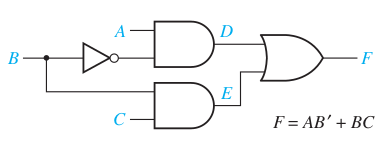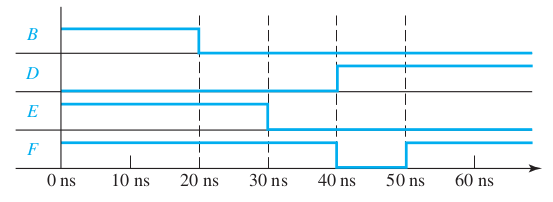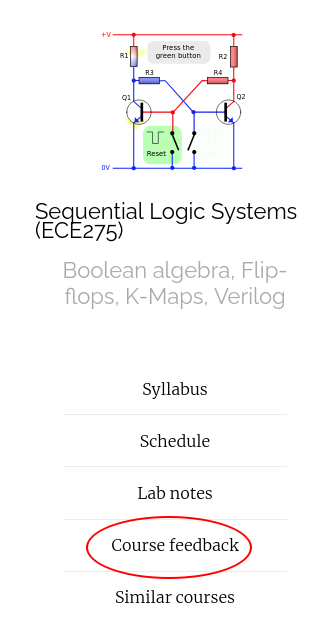ECE 275: Multi-level synthesis
Website: https://vikasdhiman.info/ECE275-Sequential-Logic/
\[
\newcommand{\bx}{\bar{x}}
\newcommand{\by}{\bar{y}}
\newcommand{\bz}{\bar{z}}
\newcommand{\bA}{\bar{A}}
\newcommand{\bB}{\bar{B}}
\newcommand{\bC}{\bar{C}}
\newcommand{\bD}{\bar{D}}
\]
Announcments
- Homework 3 is due on Sept 27th, Monday before class.
Hazards: Ex1

Assume all gates have a propagation delay of 10ns.
- Identify the transition when static 1 hazard will happen,
- draw the corresponding timing diagram,
- and modify the circuit to hazard free circuit.
Hazards: Ex1 Soln
\[ f = A\bar{B} + BC \]| \(\bar{A}\) | \(A \) | |||
|---|---|---|---|---|
| \(\bar{B}\) | \(B \) | \(\bar{B}\) | ||
| \(\bar{C}\) | 0 | 0 | 0 | 1 |
| \(C\) | 0 | 1 | 1 | 1 |
- Identify adjacent non-overlapping terms
- Identify the variable that is transitioning between them.
- Identify the longer path of the circuit with that variable.
- For a SOP circuit, the transition is that makes to 0->1 for longer circuit and 1->0 for shorter circuit.

| \(\bar{A}\) | \(A \) | |||
|---|---|---|---|---|
| \(\bar{B}\) | \(B \) | \(\bar{B}\) | ||
| \(\bar{C}\) | 0 | 0 | 0 | 1 |
| \(C\) | 0 | 1 | 1+ 1 | 1+1 |
Hazards: Ex2
Propagation delay of NOT gate=3 ns, AND/OR gate=5 ns
\[ F = (A + C)(\bA+\bD)(\bB+\bC+D)\]Multi-level synthesis
- SOP and POS are two level circuits
- Fan-in is the number of inputs to a gate
- Two-level circuits have higher fan-in, but smaller propagation delays.
- Fan-in is typically limited by the technology used.
Approaches Multi-level synthesis
- Factorization
- Functional decomposition
Factorization Ex1
\[ f = ABC + ABD + \bar{A}\bar{B}C \]Factorization Ex2
\[f_1 = ABD + CD \] \[f_2 = AB\bar{D} + C \bar{D} \]Functional decomposition Ex1
\[ f = \bx_1 x_2 x_3 + x_1 \bx_2 x_3 + \bx_1 \bx_2 x_4 + x_1 x_2 x_4 \]Functional decomposition Ex1
\[ f = \bx_1 x_2 x_3 + x_1 \bx_2 x_3 + \bx_1 \bx_2 x_4 + x_1 x_2 x_4 \]| \(\bar{x}_1\) | \(x_1 \) | ||||
|---|---|---|---|---|---|
| \(\bar{x}_2\) | \(x_2 \) | \(\bar{x}_2\) | |||
| \(\bar{x}_3\) | \(\bar{x}_4\) | 0 | 0 | 0 | 0 |
| \(x_4\) | 1 | 0 | 1 | 0 | |
| \(x_3\) | 1 | 1 | 1 | 1 | |
| \(\bar{x}_4\) | 0 | 1 | 0 | 1 | |
Functional decomposition Ex2
\[ f = \sum m(0, 6, 8, 4) \]| \(\bar{x}_1\) | \(x_1 \) | ||||
|---|---|---|---|---|---|
| \(\bar{x}_2\) | \(x_2 \) | \(\bar{x}_2\) | |||
| \(\bar{x}_3\) | \(\bar{x}_4\) | 1 | 0 | 0 | 1 |
| \(x_4\) | 0 | 0 | 0 | 0 | |
| \(x_3\) | 0 | 0 | 0 | 0 | |
| \(\bar{x}_4\) | 0 | 1 | 1 | 0 | |
Thanks, Questions, Feedback?
https://vikasdhiman.info/ECE275-Sequential-Logic/